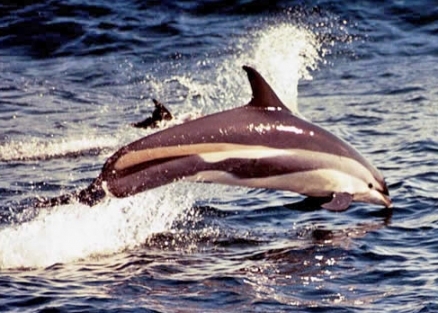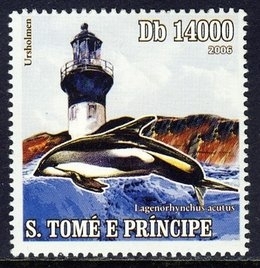Atlantic white-sided dolphin
The Atlantic white-sided dolphin, true to its name, is found in the Atlantic ocean. This cetacean is very gregarious and can be found in groups ranging anywhere from six to 1000 dolphins, and also associates with other species of dolphins and whales. The species is listed as least concern by the IUCN Red List and is protected from hunting in the Atlantic Ocean.
Contents
Physical description
The Atlantic white-sided dolphin is a large, robust cetacean, which is easily recognized by the obvious yellow patch towards the rear of the flanks. The common name refers to the pale band on each side situated below the dorsal fin. This species is often confused with the white-beaked dolphin, but the Atlantic white-sided dolphin has a much darker back. It may also be confused with the common dolphin because of the similar pattern (grey, white, black and yellow), but it lacks the distinctive hourglass pattern.
Lagenorhynchus acutus ranges from 2.5 to 3.0 meters in length. Females may be considerably smaller than males and average only 182 kilograms in body mass.
The dorsal region of Lagenorhynchus acutus is black, while its sides are gray. The ventral regions are white from the lower jaw to just past the anus. Within the gray sides are yellowish white patches, which are probably its most distinct characteristic. Black rings around the eyes are also present. The dorsal fin is tall, sharply curved and pointed at the tip, yielding the species name acutus, the Latin word for pointed; has a stocky body with sickle shaped fins and a thick tail stock. The beak is prominent with pointed teeth.
The following are distinguishing characteristics characterise the Atlantic white-sided dolphin: Colour black with yellow and white patches on side and white belly; Dives without lifting tail; Blow not readily visible; Curved dorsal fin; Small beak.
Reproduction
The species gestation period is about 10 months in length. The calves are usually born in June and July. There is usually one young per a birth, averaging about 25 kg and 107 to 122 cm in size when born. The young are typically weaned at 18 months.
Lifespan
Females become sexually mature between 1.94 and 2.22 m in length, which corresponds to about 12 years of age. The maximum longevity of males is approximately 22 years, whereas female longevity is somewhat greater, at about 27 years.
Behaviour
Lagenorhynchus acutus is a gregarious species and may be found in groups of up to 1000 individuals. However, groups of only six to eight individuals are more common off of Canada and in other places along the western Atlantic. Inshore herds are also small, ranging from about 10 to 60 animals. It seems that immature animals and newly mature males are absent from larger breeding groups, which may indicate some form of segregation among the herds.
Mass strandings of L. acutus are common on northern Altantic shores. The strandings sometimes occur in groups of three to 15 or more animals, although they usaully occur in pairs. The last major stranding of Lagenorhynchus acutus occured on Cape Cod in 1995, when approximately 30 animals were beached on the shore. Lagenorhynchus acutus does not usually survive strandings.
Lagenorhynchus acutus appears to be very nomadic but, there are no data showing a set of seasonal migrations. The distribution patterns may correspond to abundance of important prey species.
This dolphin tends to readily mix with other species of cetaceans (whales and dolphins). This fast-swimming species can often be seen breaching (clearing the water), bow-riding (riding on the bow-wave at the front of boats and even large whales), and splashing the tail flukes noisily onto the surface of the water. The dolphin also typically dives for less than five minutes.
Distribution
The distribution of the Atlantic white-sided dolphin is the cool temperate and subartic waters of the north Atlantic Ocean from southern Greenland to Massachusetts, and from the British Isles to western Norway. It has also been reported as far as the southern Barents Sea, the Baltic Sea, the Azores, and the Adriatic Sea.
Habitat
Lagenorhynchus acutus is typically found in cool pelagic waters with low salinity, where its major predators are killer whales and sharks. Since it usually prefers the open water, Lagenorhynchus acutus is not commonly seen from shore. It mostly occupies waters of 40 to 270 metres in depth around the continental shelf.
Predation and feeding habits
Major predators are killer whales and certain shark species. The prey of Lagenorhynchus acutus is typically a combination of shrimp, smelt, hake, squid and herring. Atlantic white-sided dolphins may separate from their school in order to feed more efficiently.
Conservation status and threats
It is illegal to intentionally kill, injure, or harass any cetacean (whale or dolphin) species in waters of the United Kingdom. Provisions have been made under to set up protected areas, promote research and monitoring, pollution control and increase public awareness.
IUCN Red List status for L.acutus is that of Least Concern.
Threats to this dolphin include hunting, chemical water pollution, environmental change and entanglement in fishing nets, which often results in drowning.
References and further reading
- Minasian, S., K. Balcomb, L. Foster. 1984. The World's Whales: The Complete Illustrated Guide. Washington, D. C.: Smithsonian Books.
- Encyclopedia of Life. 2010.Lagenorhynchus acutus
- North-West Atlantic Ocean species (NWARMS)
- IUCN Redbook
- CETACEA: Lagenorhynchus acutus (Atlantic White-Sided Dolphin)" (On-line). Accessed December 28, 2004
- Carwardine, M., Hoyt, E., Fordyce, R.E. and and Gill, P. (1998) Whales and Dolphins, the Ultimate Guide to Marine Mammals. Harper Collins Publishers, London.
- United Kingdom Biodiversity Action Plan (June, 2002)
- Whale and Dolphin Conservation Society (June, 2002)
- Cetacea.org (June, 2002)
- Carwardine, M. (1995) Whales, dolphins and porpoises. Dorling Kindersley, London
- Animal Diversity Web (June, 2002)
- Banks, R. C., R. W. McDiarmid, A. L. Gardner, and W. C. Starnes. 2003. Checklist of Vertebrates of the United States, the U.S. Territories, and Canada
- Banks, R. C., R. W. McDiarmid, and A. L. Gardner. 1987. Checklist of Vertebrates of the United States, the U.S. Territories, and Canada. Resource Publication, no. 166. 79
- Gray, 1828, Spicil. Zool., 1:2
- IUCN (2008) Cetacean update of the 2008 IUCN Red List of Threatened Species. Search! Klinowska, M. 1991. Dolphins, Porpoises and Whales of the World. Gland, Switzerland and Cambridge, U. K.: IUCN
- Longevity Records: Life Spans of Mammals, Birds, Amphibians, Reptiles, and Fish (Online source)
- Mead, James G., and Robert L. Brownell, Jr. / Wilson, Don E., and DeeAnn M. Reeder, eds. 2005. Order Cetacea. Mammal Species of the World: A Taxonomic and Geographic Reference, 3rd ed., vol. 1. 723-743
- Minasian, S., K. Balcomb, L. Foster. 1984. The World's Whales. Washington, D. C.: Smithsonian Books
- North-West Atlantic Ocean species (NWARMS)
- Nowak, R. 1999. Walker's Mammals of the World 6th Edition. Baltimore and London: The Johns Hopkins University Press.
- Parker, S. Grzimek's Encyclopedia of Mammals. New York, St. Louis and San Francisco: McGraw-Hill Publishing Company.
- Reeves, R., S. Leatherwood. 1994. Dolphins, Porpoises, and Whales. Gland, Switzerland: IUCN.
- Rice, Dale W. 1998. Marine Mammals of the World: Systematics and Distribution. Special Publications of the Society for Marine Mammals, no. 4. ix + 231
- UNESCO-IOC Register of Marine Organisms Search! Wilson, Don E., and DeeAnn M. Reeder, eds. 1993. Mammal Species of the World: A Taxonomic and Geographic Reference, 2nd ed., 3rd printing. xviii + 1207
- Wilson, Don E., and F. Russell Cole. 2000. Common Names of Mammals of the World. xiv + 204
- Wilson, Don E., and Sue Ruff, eds. 1999. The Smithsonian Book of North American Mammals. xxv + 750 Search! van der Toorn, J. 1999. "Atlantic white-sided dolphin" (On-line). Accessed December 28, 2004


